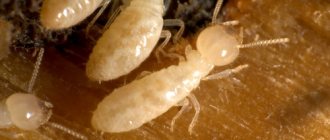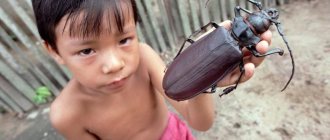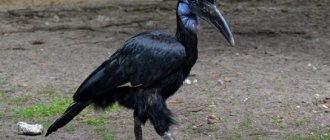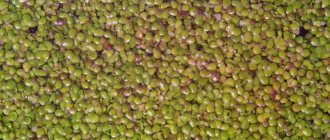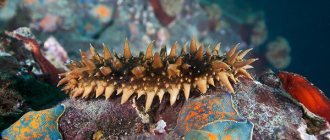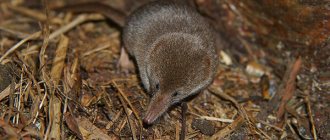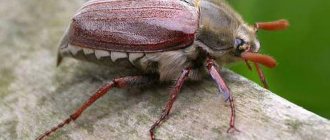Nature is diverse and amazing - it is impossible not to admire its creatures, our smaller brothers. However, although everyone is touched by baby mammals, insects seem “disgusting” and “frightening” to many. But these creatures are necessary for our ecosystem. Beetles, also known as Coleoptera, can help pollinate flowers and perform a sanitary function in the forest. Many of them have a special beauty, which is certainly noticed by children (they, as a rule, enjoy playing with beetles) and for some reason are undeservedly ignored by adults. Here is a selection of fourteen of the most beautiful beetles on the planet. We hope that your attitude towards these creatures will change, because some representatives of the species are on the verge of extinction and need protection.
Golden turtle
The “golden turtle” can rightfully be called the most beautiful beetle in the world. It looks like a jewel come to life - you could easily imagine it as a pendant on a pendant.
A very interesting fact about this “miracle of nature” is that the golden turtle can change its color depending on the level of humidity, stress or in case of death.
The “Golden Turtle” is a distant relative of the Colorado potato beetle, which is hated by all owners of gardens and summer cottages.
This beautiful bug is quite small - its size does not exceed 5-7 mm. This insect is widespread in North America.
Chemicals against skin beetle
Powdered boric acid or Borax treatment. The same drugs, in bags, are laid out between clothes on shelves for 4 hours, placed in pockets. It is useful to add "Tetrix" or "Executioner". Then the things should be washed and dried.
From aerosols they are treated with “Dichlorvos”, “Difox” or other spraying agents, applying after 1.5-2 weeks.
Anti-moth preparations are used as an additional remedy.
Use a fumigator.
Using Velcro traps or the pharmaceutical product “Parmethrin”.
Goliath beetle
Goliath is a very large and beautiful beetle. Imagine, it can weigh as much as 100 grams and occupy almost the entire human palm!
This beauty comes from Africa, where it is distributed in almost all areas. Adults prefer to live in trees and come to the ground only occasionally in search of food. Collectors are eager to acquire goliath specimens because of their impressive size and beautiful coloration - these beetles have an unusual marbled pattern.
The black parts of the pattern on the back of the beetle are very pleasant and velvety to the touch. Unfortunately, due to constant trapping, the goliath beetle is in danger.
bumblebee carpenter
The carpenter bumblebee is distinguished by its ability to build tunnels inside wood, in which it breeds offspring and overwinters.
What to do if bitten by a bumblebee
Insects choose trees for their nests that are old, dry, loose, with peeling bark; rotten stumps are also suitable. A tree or other place where a nest is formed, if its condition is suitable, bees can use for up to 14 years in a row, settling in them from year to year. Having chosen ready-made, but old, holes once left by other representatives for laying eggs, bees are able to repair them, holding the wood together with their saliva. The main condition for choosing a place for a nest is dryness and softness of the material. Insects will never choose a fresh, healthy tree. If possible, several bees make holes in the same material next to each other.
In the wood, with the help of powerful jaws, insects gnaw out a hole - an even circle, with a diameter the size of a purple bee. The passage is made from the south side of the tree and first has a horizontal direction, and then goes down and inside the tree at a distance of about 30 cm. Such a tunnel is needed for laying larvae, which will be in it one above the other and will independently go through all stages of development to a fully formed adult individual .
Interesting. The carpenter bumblebee makes a loud sound not only while flying, but also when gnawing a hole in a tree.
In the passage gnawed into the wood, the female begins laying: at the very bottom the bee adds mixed nectar with pollen for nutrition and development of the larva, the first egg is produced, then the cell is sealed, a partition is made of wood. A new egg is laid on the formed septum, and the process is repeated 6 to 10 times, the gnawed passage is completely filled. The final sealing of the entrance is done from above, so that the hole will not be visible. The female will guard the laying site for some time and then fly away. At the end of the summer season, the female that laid the eggs most often dies.
The entire clutch, and sometimes adult females, remain overwintering in the nest and fly out the next season at the beginning of summer. The formed individuals fly out almost simultaneously, gnawing through the partitions. Overwintered old females give birth to another offspring in the new season, often in the same place. New females will have to find their own place for a nest.
bumblebee carpenter
Zlatka
The goldenrod is a beetle with a very beautiful bright green metallic color, which is how it got its name. They even make jewelry from these beetles, and the British call the golden beetle nothing more than a jewel beetle, which translates as “jewelry beetle.”
Zlatki are distributed mainly in southern Asia, but they can also be found in Russia - in the Primorsky and Khabarovsk territories. The favorite habitats of borers are ash and walnut.
Most often, borers appear in June, and their lifespan does not exceed three weeks. These beetles can cause damage to trees, but their numbers are kept in check by predators and parasites.
Bites during pregnancy and children
Bumblebee bites that strike a pregnant woman are especially dangerous. Since the body’s protective functions are not able to fully combat the toxic substance, complications may arise that are dangerous for both the mother and the baby. Individual intolerance to the components of bumblebee venom, an allergic reaction of the mother or a dangerous bite site can provoke pregnancy complications, bleeding, and premature birth.
Young children and people with chronic diseases are also at risk. In such cases, the immune system cannot fight external pathogens, and severe consequences often occur.
Therefore, it is important to consult a doctor in time to prevent the development of complications.
Bronzovka
Another beautiful shiny bug. The bronze beetle also includes the well-known inhabitant of summer cottages - the cockchafer.
Some bronzes have the most common black color, without any hint of a beautiful metallic sheen. These beetles are much faster than their other flying counterparts. Shiny bronzes can be green, blue, copper and purple and gold.
Unfortunately, these beautiful beetles are pests - they eat young fruits of fruit crops, cabbage, carrots, and beet leaves, and also gnaw out the stamens and pistils of flowers, which makes their further pollination impossible.
Herbivorous (polyphage)
As the name suggests, this category unites a wide variety of beetle species, photos of which do not give any idea of the principle of their classification into this group. This includes peculiar representatives, for example, water lovers, who cannot swim, but fly beautifully, and little ones who can pretend to be dead by tucking their legs and antennae.
There are little ones that live only in anthills, feeding on the corpses of ants, but do not disdain larvae. Dead eaters are the most colorful of all families:
- Gravediggers (more than 20 species in Russia) are usually black in color, but may have orange details on their vestments, baldrics or spots. These named beetles process biological debris already buried in the soil and lay eggs in it. They have an increased ability to sense potential breeding habitat, and even bury it in the soil if it is small in size.
- What is most interesting is that a beetle such as the matted carrion beetle, despite its name, eats beets and other plants, and the beetle larvae of some other carrion beetles also feed on plant foods.
- Aleoharas, a type of flying beetle, are considered beneficial Coleoptera because their larvae feed on fly pupae. In this way, they help destroy fruit flies (onion and cabbage flies), which sometimes pose a real disaster for agricultural crops.
- Stag beetles look great in photos. Adult males with horns can reach a length of 7.5 cm. Now they are quite rare, due to the long period of development of the larvae, which matures for about 5 years, and the destructive activities of humans, modifying their usual habitat.
- The rhinoceros beetle is also colorful. But the passalids are interesting because of their way of life - they live in pairs and feed their children through joint efforts. The parents of these beetles have to feed the larvae with specially prepared food. They chew wood and feed it not only to larvae, but also to small beetles. Also known as sugar passalids, they “talk” to each other by rubbing the tip of the wing against the abdomen.
The largest group is the lamellaridae. These beetles are known to most people. These include dung beetles, including the bulbous aphodia, which are often found in cow dung or horse manure (and some of them can exist in a specific type of biological waste). In the photo you can recognize other beetles - the mobile-horned dung beetle, the many-horned dung beetle, the black beetle with 2 horns or the red beetle, with a huge head and large mandibles.
Having plunged into this diverse and colorful world in childhood, many coleopterologists have retained not only their childhood admiration for the organization, adaptability and meaningfulness of the existence of beetles. They consciously began to study the inhabitants in order to comprehend the feasibility and adaptability of the natural cycle. Just look at the fireflies, of which there are about 2 thousand names. They are capable of producing light due to photogenic holes located at the end of the abdomen.
Picasso beetle
The Picasso beetle is also called the “sink bug.” This unusual insect lives in Ethiopia and Cameroon. Its bright color serves to scare away potential enemies.
Strictly speaking, the Picasso beetle is not a beetle at all, but a bug.
Like all bedbugs, this beauty has the ability to release a pungent, foul-smelling liquid. When shield bugs gather in large groups, they can cause significant damage to plants.
Bottom line
Here we have presented a photo with the names of representatives of the Coleoptera order. To summarize, let us turn to the etymology of the word “beetles”. It comes from two ancient Greek words “scabbard” and “wing”. But Slavic is logically derived from the verb “buzz.” The editors of most-beauty.ru ask you to write in the comments what other beautiful species of beetles, in your opinion, should be included in this list.
And below we decided to post a few more beautiful photographs with different types of beetles:
That's all for now! We look forward to your comments.
Ladybug
This insect is very common in our latitudes, and everyone has seen a ladybug at least once in their life. Ladybugs are very often elevated to the rank of mystical creatures - there are many folk superstitions associated with them, and in some cultures killing a ladybug is considered a serious crime. A small beetle with black spots on a red back really looks very cute, and, unlike other insects, does not cause negative emotions at all.
The lifespan of a ladybug is about a year, and the older the insect, the more faded its color becomes. Despite such a harmless appearance, ladybugs are true predators (with the exception of some species). They deal with aphids and other agricultural pests.
Methods to combat bugs
If black beetles appear in the apartment, then first you should determine their type based on external signs.
Depending on the identification, you can use various control methods to help get rid of black beetles:
- Carpet beetles and carpet pests should be combated by treating carpets and furniture; first they must be wiped with a sponge soaked in a soap solution, and then with a vinegar solution; a day after treatment, carpets and furniture should be vacuumed well, and the contents of the bag should be thrown away, as there may be insect eggs in there;
- to destroy flour beetles, it is necessary to carefully sort through all reserves of bulk products (flour, cereals, sugar, etc.); if they are found, everything must be thrown away, because they are not suitable for consumption;
- inspect the contents of all cabinets for small black or red bugs, then make a solution of 1 tbsp. l. soda per 1 liter of water and treat all surfaces and shelves inside the cabinets, wash the dishes using detergents and pour boiling water over them;
- wash all surfaces in the kitchen with a solution of acetic acid or use boric acid powder, which should be rubbed into areas where parasites may live;
- treat the floor covering and baseboards with any aerosol containing an insecticide against insects (Dichlorvos, Combat, Raid, etc.);
- clothes should be boiled or washed in hot water (not lower than +60°C).
On a note!
The procedure for exterminating insects should be repeated 2 times a week for a month, since new generations of bugs will hatch from the laid eggs of insects, which also need to be destroyed.
If the measures taken do not help or there is no time to fight bugs in the apartment for a long time, then it is better to turn to professionals. There are companies that use special preparations to carry out disinfestation (extermination of pests) in any residential premises.
Fighting bugs in the house
Alpine barbel
This beetle can be found not only in the Alps - it lives in the Caucasus, the Carpathians, and the Crimea. Handsome longhorned beetles prefer to live in mountain forests.
They live, as a rule, on old and decaying beeches, maples and oaks. Unfortunately, the alpine longhorned beetle is now on the verge of extinction, and its population is constantly declining. This beetle can have not only a blue color - there are individuals with black, gray, and even pale pink hair.
Longhorned beetles are extremely thermophilic, so they can only be seen from July to September.
Why is a tree bumblebee bite dangerous?
What does a bumblebee look like?
The bumblebee, due to its biological characteristics, does not bite, but stings, introducing a toxic composition under the human skin. Only the female of the species, which is not aggressive in nature, is capable of stinging. When confronting a person, the possibility of avoiding a bite is high. It is rare to see a female building a nest, but the bee will defend itself and the created tunnel with its offspring if something threatens it.
Important! To avoid unnecessary contact, the insect should not be irritated or approached close to it. The carpenter bee is twice as large as the usual honey bee, so its bite is noticeably more painful.
The bite of a carpenter bumblebee is dangerous due to the poison in its sting and severe swelling of the bite site. If a skin puncture can only result in painful sensations that subside after a while, then a sting in the eye, nose or throat is life-threatening. A bite to the neck can cause suffocation due to swelling or allergic reactions.
Important! If you need to remove an insect nest, you should definitely use protective clothing, especially on exposed areas of the body.
Insects of the xylocope species are especially active in spring.
Black bumblebees do not like noise, so you can drive them out by making loud noises near the nest.
The place where the bumblebee carpenter worked will be revealed by a perfectly even hole in the wood, as if drilled with a construction tool, and piles of shavings nearby.
Bumblebee sting
Fanous
Fan whisker beetles are known precisely for their gorgeous mustache, consisting of at least twenty segments and resembling thickly painted eyelashes.
They are so rare that they are one of the least studied representatives of their species today. Fanwhiskers live in Australia and can only grow up to 25 millimeters.
Whiskers serve males to pick up pheromones from females of their species, and to understand how ready the female is for mating. The number of male fanwhiskers significantly exceeds the number of females, so they often have to fight among themselves for a fertile individual.
Appearance of an insect
The larva of the gray blowfly reaches 2-3 millimeters. It differs from most larvae of other species in that its rear part is equipped with a respiratory recess in the form of a cup with special valve plates.
This extravagant arrangement of the spiracles provides the larva with the opportunity to dive into liquids and grab onto meat with its mouth hooks, without fear of suffocation, since the back part is exposed to the air. An interesting effect can be observed from the accumulation of many feeding larvae: their exposed and moving spiracles resemble sea anemones.
Fruited nut
This is a very small bug with a very long proboscis, which is also often called the nut weevil. The nut fruit can be found in the European part of Russia and the Caucasus. The beetle's body is completely covered in brownish-yellow hairs, making it look like a miniature version of a sparrow.
Fruit veins emerge at the end of spring, when the weather is warm enough. They feed on leaves, hazel fruits, hazelnuts and acorns. Weevil larvae eat the nut kernel and fill its cavity with excrement. They are considered pests and are actively destroyed by owners of summer cottages.
elephant beetle
This beetle got its name due to its very impressive size - one of the largest insects on the planet. Typically, elephant beetles grow up to 12 centimeters in length.
Males have an impressive horn on their heads, which is used in fights with members of their own species and potential enemies. This beetle can be found in Mexico, Central America and Australia. It's surprising, but many Russians keep elephant beetles in their apartments as pets - despite the fact that the lifespan of these insects does not exceed five weeks.
In their natural habitat, elephant beetles feed on tree sap. And at home, caring owners feed them lychees and pineapples - and the beetles happily eat the fruit.
Features of larval development
The first instar larvae, after emerging from the earthen burrow, climb onto flowering plants, where they wait for bees. They cling to hymenoptera insects, which carry the larvae to their own nest. Once in a bee's home, the first thing they do is eat the egg. The larvae grow and develop at the expense of food reserves prepared in the nest. The victims of parasites are solitary bees of common genera: Osmia, Anthophora, Nomia. They build nests and lay eggs in the ground. Violet T-shirts live nearby, the development of which is impossible without their owners.
The body of triungulina is flat, yellow, size 1.7-2 mm. The head has pointed sickle-shaped jaws and eyes. The abdomen ends in two long setae. The legs are long, the paws have sharp claws that allow them to stay on the bee's body. After molting, the legs shorten and the eyes disappear. The larva eats honey reserves, grows and molts several times. Some parasites pupate in the bee's nest, but most leave it and burrow into the ground to a depth of 10 cm.
By autumn, the larva turns into a “false pupa”, characterized by a durable chitinous cover. In this state, she does not feed and enters winter diapause. A dense cocoon protects against drying out, climatic influences and mechanical damage. In the spring, a larva emerges from it and turns into a pupa. After a few days, the imago emerges from it.
Brazilian bigtooth lumberjack
One of the largest beetles in the world - the size of the largest individual of the Brazilian bigtooth woodcutter is 17.8 cm. It lives in the forests of Colombia, Brazil, Peru, Ecuador and Colombia.
This insect spends up to ten years in the larval stage, but the life of an adult woodcutter, alas, is limited to several months. Thanks to its very impressive size and beautiful colors, this beetle is a dream for any collector.
Dried specimens are considered an excellent interior decoration. Beetles are very expensive, but this does not bother exotic lovers - they like the opportunity to frame this rare and beautiful insect, and they are ready to pay any money for it.
Preventive measures
It is very difficult to get rid of the bark beetle completely and quickly. Therefore, it is necessary to carry out prevention, which consists of certain measures.
Skin beetle larva.
- Keep the room clean, carry out wet cleaning regularly, and if possible, treat hard-to-reach areas with a steam generator.
- Place moth repellents in places where things and food are stored.
- Carry out regular audits and get rid of old, unnecessary things.
- Cover windows and ventilation holes with mesh.
Stag beetle
If you come across a stag beetle, please do not harm it - they are absolutely harmless to humans, and their population is declining, which is why they are listed in the Red Book.
Stag beetles are in danger due to deforestation, sanitary treatment of trees, and people accidentally finding the beetles and regularly taking them home out of curiosity. The stag beetle is one of the largest beetles living in Europe - its size reaches eight to nine centimeters. In ancient times, there was a special attitude towards these beetles - dried specimens were used as an amulet to scare away enemies and were worn around the neck. The stag beetle got its name because of its developed upper jaws, reminiscent of antlers. Developed jaws are found only in males of this species, and are used for males of this species to fight among themselves and scare off ill-wishers.
Breeding
For those who are not against breeding blow flies, and in particular their maggot larvae, this section of our story is intended. We will tell you how to make the simplest maggot from our favorite material for all kinds of crafts - an indispensable plastic bottle.
This is done as follows:
- Cut the plastic bottle into two parts so that the upper part with the neck, being turned over and inserted into the lower half, does not reach the bottom by 4-5 centimeters.
- Pour sawdust into the lower part of the “one and a half” or “kopeck piece” in a layer of two to three centimeters.
- Place a piece of fresh or spoiled meat or a piece of fish in the upper part. By the way, you can also add a few small fish that you discarded after fishing.
- Place the maggot in a shaded area.
When the meat begins to spoil, the flies will smell it and lay eggs there. The hatched larvae will feed on the substrate offered to them. Soon, a week after their eggs hatch, they will stop feeding in preparation for pupation, and will leak through the neck of the bottle straight into the sawdust.
Thanks to crawling in sawdust, maggots will be cleared of the smell of carrion, and you can take them with you fishing without hesitation. If you put an egg in a maggot, the larvae will be the largest.
Hercules beetle
Another very large beetle in our selection. The record documented adult size is 17 centimeters.
The back of the Hercules beetle is covered with fine light red hairs, and the head and pronotum are glossy black.
Very rarely there are individuals with a blue color. The Hercules beetle has large horns on its head. Females of this species do not have horns, and are usually darker than males.
What does it look like
The blue blowfly is the largest of this type of insect. Its body length is about 1.5 cm. It buzzes very loudly when flying, which is very reminiscent of the sound that a bee makes. The body has a blue color with a faint light coating. On the yellow-red head, shimmering with a golden sheen and covered with black hairs, there are dark antennae and faceted eyes of a red-brown hue.
The insect's thorax is black with a bluish tint; dark longitudinal stripes are noticeable on the mesoscutum. The carrion moth has transparent wings that do not overlap each other when at rest.
Diamond Beetle
Compared to other heroes of our selection, the diamond beetle is very tiny - it does not grow more than three centimeters. Its body is black, with rows of bright green dots, and its wings have a golden-green hue.
You can see the diamond beetle only in Brazil - there are so many of these insects there that tree branches bend under their weight. Previously, dried specimens of diamond beetles were often used to make jewelry. It was for these purposes that diamond beetles once began to be supplied en masse to Europe.
Prevention
To combat blue flies, a person must take a number of preventive measures:
- remove garbage regularly;
- install garbage containers on special, paved areas;
- on livestock and poultry farms it is necessary to equip sewage drains and concrete floors;
- Install mosquito nets on windows.
It is impossible to provide complete protection against insects with preventive work alone. It is necessary to thoroughly clean the premises and use existing means for their destruction:
- sticky tapes;
- traps;
- chemicals and folk remedies.
Emulsion larvicides are used to kill pupae. For adults - known effective insecticides.
Fighting blue flies
Review
I don’t know what kind of flies fly into my house, but sometimes I paid attention to their color. There were bluish and greenish individuals. For protection I most often use adhesive tape.
Natalya, Kursk
